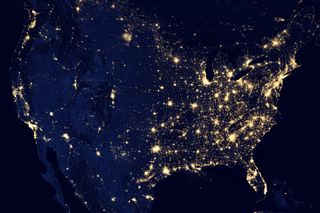International Dark Sky Week 2023 begins today to combat the light pollution crisis
Skywatchers will use the period between Saturday, April 15 and Saturday, April 22 to ensure that policymakers aren’t in the dark about the problem facing our view of space.

Light pollution from a variety of sources, both on the ground and in orbit, is threatening the night sky at an alarming rate.
According to one recent study, the world is currently seeing an average increase of 9.6% in the brightness of the sky. This means that whereas 18 years ago, skywatchers would see an average of 250 stars in the night sky; today, only 100 would be visible.
The International Dark Sky Association hopes to raise awareness about the growing light pollution crisis with International Dark Sky Week 2023. The event begins Saturday, April, 15 and will see astronomers and skywatchers attempting to raise awareness of the damage that light pollution can do to observations of space from Earth. Today through Saturday, April 22, astronomers of all skill levels across the globe are encouraged to take part in activities that celebrate the wonders of the night sky and call attention to what each of us can do to combat light pollution.
Related: Light pollution is erasing stars from the night sky at breakneck pace. It's only going to get worse.
The eight-day event has a serious cause, pointing out the need to protect our natural nighttime environment to policymakers and the public, as well as illustrating how vital dark skies are to our ongoing investigation of space.
"It may seem harmless, but light pollution has far-reaching consequences that are harmful to all living things," International Dark Sky Association writes on the event website.
Light pollution, defined as unneeded artificial light flooding the night sky, has increased significantly alongside the growth of technological advancements over recent decades and the increase in the number and size of urbanized and industrialized regions.
Get the Space.com Newsletter
Breaking space news, the latest updates on rocket launches, skywatching events and more!
According to the International Dark Sky Association, light pollution is actually growing at twice the rate as the human population. This disturbs natural habitats decreasing the reproduction and migration rates of species of mammals, birds, insects and reptiles, while simultaneously increasing the risk of predation. That's without even considering how this form of pollution affects the view of stars in the night sky.
It is estimated that 83% of humans currently view a light-polluted sky, according to the association. In urban areas, a great deal of light pollution comes from outdoor lighting used at night that is inefficient, overly bright, poorly targeted or improperly shielded, the association says. The organization, founded in 1988, adds that in many cases, this lighting is completely unnecessary, spilling into the sky rather than being focused on the objects and areas that need to be illuminated. Though a rapidly growing problem, light pollution can be combated.

"Effective outdoor lighting reduces light pollution, leading to a better quality of life for all," the International Dark Sky Association writes. "The dark sky movement is working to bring better lighting to communities around the world so that all life can thrive."
Skywatching enthusiasts or anyone interested in protecting the human birthright of the night sky can take action during International Dark Skies Week to help raise awareness of this issue. An outreach package created by the International Dark Sky Association details some of the events you could organise to contribute to this effort. These ideas include hosting a walk night in your local community, hosting a star-gazing party, or holding an "Ask me Anything" session on social media about the effect of light pollution on astronomy and our view of the stars. Ideas for International Dark Sky Week 2023 events can be submitted here.
The outreach package also includes blurbs and banners that can be used on social media to help raise awareness. Those aiming to make a more prolonged contribution to the cause can become Dark Sky Advocates, educating the public about light pollution, helping enact legislation and serving as local resources for other volunteers. Enrolment for interested potential Dark Sky Advocates is here.
A more complete list of ways to support International Dark Sky Week 2023 can be found on the International Dark Sky Association website.
Follow us @Spacedotcom, or on Facebook and Instagram.
Join our Space Forums to keep talking space on the latest missions, night sky and more! And if you have a news tip, correction or comment, let us know at: community@space.com.

Robert Lea is a science journalist in the U.K. whose articles have been published in Physics World, New Scientist, Astronomy Magazine, All About Space, Newsweek and ZME Science. He also writes about science communication for Elsevier and the European Journal of Physics. Rob holds a bachelor of science degree in physics and astronomy from the U.K.’s Open University. Follow him on Twitter @sciencef1rst.
